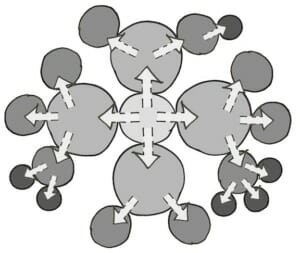Domains in sociocracy – while they are innocent-looking, they are the foundation that makes sociocracy so transformative – with empowerment, and clarity!
So what are domains?
Each circle has
- an aim (a description of what they do), and
- a domain (a statement of what they are responsible for and have authority over).
Why is it important to define a domain?

Defining a domain makes things super clear. For every issue, problem, policy, and task, it’s obvious where it “lives”. For example, the key to the storage closet disappeared? Basement Circle is in charge. The website has a typo – Website Circle will know how to fix it. Want to know how to support your organization’s social media presence? Ask Social Media Circle. It’s important to know that whoever owns the domain is the final authority in that domain. So Social Media Circle decides about everything social media. For example, if they decide to ghost Facebook, they are allowed to do that.

With decentralized authority, it’s not always the same people (like the boss or the Executive Director) who get asked everything. We spread out the responsibilities so that more people in the organization can carry leadership. Yet for each of them, it’s not a huge job – instead, they take a manageable chunk that fits their expertise. It’s modular, and you have full control how you chunk the domains into circles when you start.
Domains are held collectively as a circle for making policy decisions. But we can also give smaller parts of our circle domain to one person in a role. That way, the circle has time to think about the wider perspectives and how everything in their domain fits together,while individual members in roles hold the small pieces safely. Since the circle is still responsible for the domain, those individuals have a clear group to go to if they need help. It’s empowering – without leaving people in the rain.
Using domains to distribute power
The following explains the decentralized nature of domains:

- Take all the decisions that could be made in an organization and drop them in the middle of the organization. That’s the General Circle (GC).
- Yet, the GC doesn’t hold on to that decision-making power. Instead, the GC gives the authority/responsibility to circles, like pieces of a pie or a pizza.
- Now we have a few department-level circles that hold that authority while the GC only makes sure everything aligns and fits well. Note that the General Circle hardly makes decisions on things now (because ideally, basically everything has been passed on). All they do is decide who decides.
- Some of those circles might keep a piece of the pie (and they remain decision-makers in that part of their domain), but the overall chunk might be too big for them – too much to do and too many details to pay attention to. So they cut a chunk of their piece and pass it to a subcircle of theirs. Now that subcircle is the decision-maker on that chunk. And so on. (Of course, one can only pass on a domain to a sub-circle that one already owns.)

Clear domains empower workers
Domains are flexible – you can define them the way you want to. Yet, they need to be defined – if you don’t know who is doing what, some people will be comfortable just deciding things, and some will never really step into action because they are waiting to be given approval to do things.
Domains can (and certainly will) also change over time – all you need to do is make a proposal to change them and get consent from everyone in the group and from the circles affected by the change. As we do our work, we will continuously refine and adapt in the way we spread domains.
If there’s an entirely new thing that hasn’t been distributed yet (for example, if your organization acquires a new building or a completely new project), we find a place for it by consent. Whereas, if we have no idea where to put it, then the General Circle has to play catch-all and find a place for the decision. If a problem hits several domains at once, the GC negotiates where it fits the best so it can be settled in one place, with everyone’s input.
This approach combines clarity with flexibility, small groups with big picture thinking and alignment, empowerment of groups and individuals with responsibility. It’s a design pattern that we can use indefinitely – with a place for everything and everything in its place.



Leave a Reply
You must be logged in to post a comment.